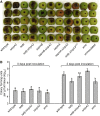Extragenic Suppression of Elongation Factor P Gene Mutant Phenotypes in Erwinia amylovora
- PMID: 30885930
- PMCID: PMC6509650
- DOI: 10.1128/JB.00722-18
Extragenic Suppression of Elongation Factor P Gene Mutant Phenotypes in Erwinia amylovora
Abstract
Elongation factor P (EF-P) facilitates the translation of certain peptide motifs, including those with multiple proline residues. EF-P must be posttranslationally modified for full functionality; in enterobacteria, this is accomplished by two enzymes, namely, EpmA and EpmB, which catalyze the β-lysylation of EF-P at a conserved lysine position. Mutations to efp or its modifying enzymes produce pleiotropic phenotypes, including decreases in virulence, swimming motility, and extracellular polysaccharide production, as well as proteomic perturbations. Here, we generated targeted deletion mutants of the efp, epmA, and epmB genes in the Gram-negative bacterium Erwinia amylovora, which causes fire blight, an economically important disease of apples and pears. As expected, the Δefp, ΔepmA, and ΔepmB mutants were all defective in virulence on apples, and all three mutants were complemented in trans with plasmids bearing wild-type copies of the corresponding genes. By analyzing spontaneous suppressor mutants, we found that mutations in the hrpA3 gene partially or completely suppressed the colony size, extracellular polysaccharide production, and virulence phenotypes in apple fruits and apple tree shoots but not the swimming motility phenotypes of the Δefp, ΔepmA, and ΔepmB mutants. The deletion of hrpA3 alone did not produce any alterations in any characteristics measured, indicating that the HrpA3 protein is not essential for any of the processes examined. The hrpA3 gene encodes a putative DEAH-box ATP-dependent RNA helicase. These results suggest that the loss of the HrpA3 protein at least partially compensates for the lack of the EF-P protein or β-lysylated EF-P.IMPORTANCE Fire blight disease has relatively few management options, with antibiotic application at bloom time being chief among them. As modification to elongation factor P (EF-P) is vital to virulence in several species, both EF-P and its modifying enzymes make attractive targets for novel antibiotics. However, it will be useful to understand how bacteria might overcome the hindrance of EF-P function so that we may be better prepared to anticipate bacterial adaptation to such antibiotics. The present study indicates that the mutation of hrpA3 could provide a partial offset for the loss of EF-P activity. In addition, little is known about EF-P functional interactions or the HrpA3 predicted RNA helicase, and our genetic approach allowed us to discern a novel gene associated with EF-P function.
Keywords: DEAH-box RNA helicase; Erwinia amylovora; apple; elongation factor P; fire blight; ribosome.
Copyright © 2019 American Society for Microbiology.
Figures







Similar articles
-
Virulence Genetics of an Erwinia amylovora Putative Polysaccharide Transporter Family Member.J Bacteriol. 2020 Oct 22;202(22):e00390-20. doi: 10.1128/JB.00390-20. Print 2020 Oct 22. J Bacteriol. 2020. PMID: 32839177 Free PMC article.
-
An Erwinia amylovora yjeK mutant exhibits reduced virulence, increased chemical sensitivity and numerous environmentally dependent proteomic alterations.Mol Plant Pathol. 2018 Jul;19(7):1667-1678. doi: 10.1111/mpp.12650. Epub 2018 Feb 1. Mol Plant Pathol. 2018. PMID: 29232043 Free PMC article.
-
Erwinia amylovora Auxotrophic Mutant Exometabolomics and Virulence on Apples.Appl Environ Microbiol. 2019 Jul 18;85(15):e00935-19. doi: 10.1128/AEM.00935-19. Print 2019 Aug 1. Appl Environ Microbiol. 2019. PMID: 31152019 Free PMC article.
-
Molecular genetics of Erwinia amylovora involved in the development of fire blight.FEMS Microbiol Lett. 2005 Dec 15;253(2):185-92. doi: 10.1016/j.femsle.2005.09.051. Epub 2005 Oct 13. FEMS Microbiol Lett. 2005. PMID: 16253442 Review.
-
Fire blight: applied genomic insights of the pathogen and host.Annu Rev Phytopathol. 2012;50:475-94. doi: 10.1146/annurev-phyto-081211-172931. Epub 2012 Jun 11. Annu Rev Phytopathol. 2012. PMID: 22702352 Review.
Cited by
-
Virulence Genetics of an Erwinia amylovora Putative Polysaccharide Transporter Family Member.J Bacteriol. 2020 Oct 22;202(22):e00390-20. doi: 10.1128/JB.00390-20. Print 2020 Oct 22. J Bacteriol. 2020. PMID: 32839177 Free PMC article.
-
Translation elongation factor P (EF-P).FEMS Microbiol Rev. 2020 Mar 1;44(2):208-218. doi: 10.1093/femsre/fuaa003. FEMS Microbiol Rev. 2020. PMID: 32011712 Free PMC article. Review.
References
Publication types
MeSH terms
Substances
LinkOut - more resources
Full Text Sources
Research Materials

